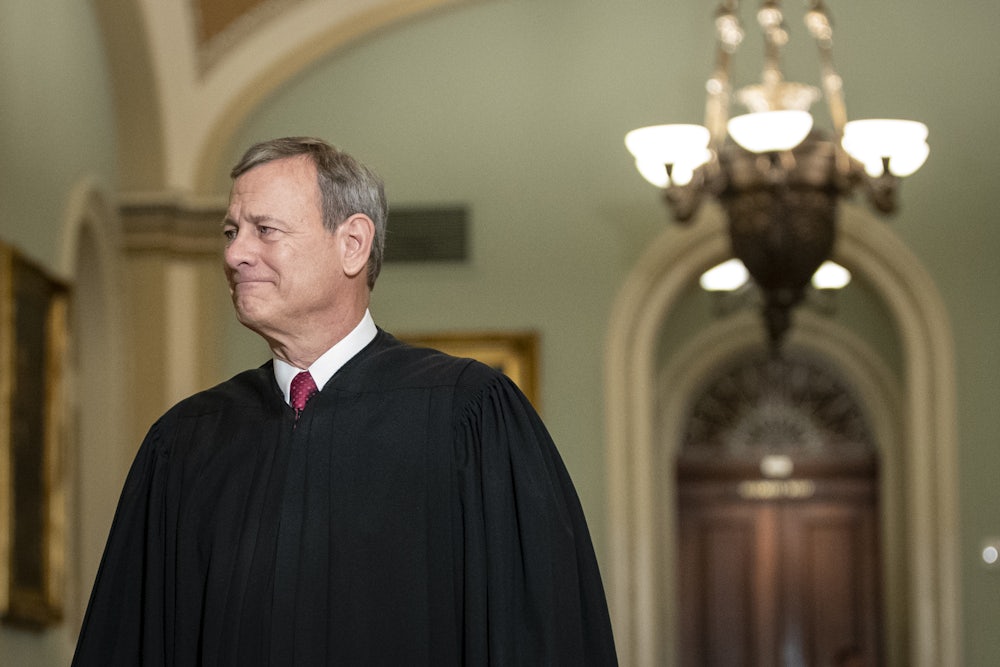The failure of Democrats to surmount a Senate filibuster and pass out of that body a bill that might create a bipartisan committee to investigate the events of January 6 is a gut check for Democrats, who should no longer treat the procedural relic as a potential or imaginary threat to their governing agenda. Their inability to unite against the filibuster and end this sorry practice is solely on their shoulders, and they should be moving heaven and earth to dislodge this infernal practice from the upper body. Allies in this mission are, unfortunately, in too short supply in their own caucus.
Perhaps they should instead look to the courts—yes, even the Supreme Court. As implausible as it might seem, a lawsuit to knock out the filibuster might have a chance, even in a high court dominated by conservative justices. The reason being: It is in the institutional interests of the high court to get rid of it. And if those justices truly believe what they claim, they might discover that the best reason to save the Senate is to save themselves.
To begin at the beginning: It is not the old “talking” filibuster from the popular imagination of the public that such a suit would challenge. Under Article I of the Constitution, the Senate is entitled to have its own procedural rules, and cloture—ending debate in a talking filibuster—was procedural. All the majority had to do was simply wait out the talk, and there would sooner or later be a vote. In this way, cloture was understood as a process that provided an efficient way to get to a vote faster.
But it is not possible to wait out today’s perversion of the form: the “silent” filibuster. The silence is both instantaneous and eternal. Moreover, it is neither an alternative procedure nor a time-saving way to get to a majority vote. Rather, a supermajority must agree if there is to be a majority vote at all. There is also no principled rule for when this absolute supermajority requirement applies. It is at the whim of the minority. But the most important thing to remember is that as it is not a procedural rule, but rather a change in the enactment of law by majority vote, the filibuster is neither permitted by Article I, nor is it permitted with the consent of the House, which is the wronged party here.
Had the Framers gotten an inkling that this is what the filibuster would become—and in 1789, nothing like it existed anywhere in the world—they would have taken steps to explicitly ban its implementation. One of the reasons the Constitution even exists is that the Framers wanted to get rid of the dysfunctional supermajority rules laced through the Articles of Confederation. A supermajority rule, Madison wrote in Federalist No. 58, reverses the principle of free government.
The Founding Fathers had a different idea for limiting the power of Congress: Divide it into two chambers. Just last year, in Seila Law v. Consumer Financial Protection Bureau, the court explained this as follows: “The Framers viewed the legislative power as a special threat to individual liberty, so they divided that power to ensure that ‘differences of opinion’ and the ‘jarrings of parties’ would ‘promote deliberation and circumspection’ and ‘check excesses in the majority.’”
The silent filibuster restores the very undemocratic supermajority barriers that the Constitution’s framers went out of their way to reject. Worse, the legislature is now checked by both the supermajority burden and the bicameral check and balance the Framers invented. It is difficult to imagine what would have happened if we had this form of government during the Great Depression. Even with check and balance alone, we ended up with just half of the New Deal that Roosevelt intended.
But why might any of this bother the high court’s justices? The reason: The supermajority rule also inflicts an institutional injury on the Supreme Court.
It is important to understand here just why the Framers divided the Congress into two chambers: to weaken the legislative branch just enough to keep it from invading the function of the judicial and executive branches. But by the same thinking, if the legislative branch is too weak, the danger arises of the judicial or the executive branches invading the lawmaking functions. If Congress is incapable of acting, presidents will make law by executive order. And the Supreme Court will engage in even more de facto lawmaking than it used to when the legislative action was not limited by a supermajority rule but only by the original, constitutional check and balance.
Here is just one example from the last Supreme Court term: In Bostock v. Clayton Co., Georgia, the court held that Title VII of the Civil Rights Act of 1964 also covers discrimination against the LGBTQ community. This form of judicial reasoning is called gap filling, and in this instance, the gap was a big one. Maybe Bostock came out the right way, but in many countries, there would have been no case in the first place. It would have been a parliamentary matter—decided in a flash. Congress would have done its job. Similarly, it is hard to imagine a decision like Roe v. Wade in any country with a legislature capable of acting. Lacking that, the court decided by 5 to 4.
If the filibuster were gone, the court would be better able to perform the limited and truly judicial role that conservatives espouse—or at least pretend to embrace. It would be easier to permit the style of judging known as judicial formalism—the calling of “balls and strikes.” The principle here is that courts exist to apply rules. They exist to carry out “the will of the sovereign.” That is the only judicial role: to separate law from morals, or court-imposed ideals. It is the argument made by H.L.A. Hart in his classic The Concept of the Law, and in such other writings as “Positivism and the Separation of Law and Morals.” It all comes down to enforcing the will of the sovereign, as expressed in law.
But this whole project is doomed if there is no “will of the sovereign” for the judicial branch to carry out. What the judicial right wants depends on a legislative body as capable of acting as the British Parliament. By making it harder for the will of the sovereign to be expressed, the Senate filibuster makes it harder for judges to be judges.
In Seila Law, the court rather flippantly notes that under our 1789 Constitution, “the atom of sovereignty is smashed.” Well, in our time, thanks to the filibuster, that atom has now been smashed into even smaller subatomic particles, and the chain reaction it has set off is melting down the country. As the gaps in the laws become bigger than canyons, even conservative judges are forced into a whole range of gimmicks and stratagems to deny what they must know they are doing. It is judicial activism deemed illegitimate by the very judges who practice it.
But even conservative justices believe that there is a special duty to hear cases involving the separation of powers. As Justice Kennedy once wrote, “policing” the “enduring structure” of constitutional government when the political branches fail to do so is “one of the most vital functions of this Court.” In that same case, in a concurring opinion, Justice Scalia wrote that when the Constitution’s governing structure is at issue, it is the “solemn responsibility” of the judicial branch to say “what the law is.”
No challenge to the filibuster has ever reached the Supreme Court—but several challenges have failed in the lower courts. Each case has been dismissed on technical grounds, but there might be ways around this.
The members of the House of Representatives are best suited to be the plaintiffs in such a complaint. If these House members frame the suit in the right way, the technical grounds that lower courts have used to dismiss these suits in the past will disappear. Does the filibuster cause a true legal injury to the House members bringing suit, either in their official “political” capacity or their private individual capacity? Often in the past when members of Congress have sued the president in their official capacity, they have argued that there is a law or act that infringes on the power of Congress.
In Raines v. Byrd, for example, the late Robert Byrd sued to challenge the Line Item Veto Act, which interfered with Congress’s exclusive power over appropriations. But the court would have none of it—if the Line Item Veto Act infringes on the power of Congress, don’t come to us, the court said. Congress was free to repeal the law if it wanted to do so. There is no injury to members of Congress in their official capacity, or to their political powers, if the injury is one that the Congress can redress.
But the House cannot remedy the injury of the filibuster on its own—it stands as an unconstitutional check on the lower chambers’ ability to be the representative of the majority. The filibuster is a diminishment of the power granted to the House in the Constitution. It is also an injury to House members in their personal or individual capacity as citizens. The voting rights bill, for example, would ban political gerrymandering that rigs a vote against members of Congress, and so be of benefit to them personally. It would protect them as candidates in other ways, enabling them to clean up corruption in campaign fundraising, for example.
In the last legal challenge to the constitutionality of the filibuster, the U.S. Court of Appeals considered a suit by Common Cause, its members, and others, including House members, over the failure of the Senate to pass the Dream Act in 2010, when the Democrats still had a majority. By 2014, when the case reached the U.S. Court of Appeals, the case was pointless. In Common Cause v. Biden—yes, that Biden—the court dismissed it because the vice president himself as chair had not caused any injury. Rather, it was an “absent third party” that had done so: the entire Senate itself. The court noted it would be impossible to sue senators under the Speech and Debate Clause. The vice president and parliamentarian might issue rulings against the filibuster, but the senators could overturn them.
But the vice president has a legal duty to defend the rules of the Senate—and there is a real controversy over whether the rules are constitutional. It is only the vice president, as chair, who can answer whether the cloture is a proper procedural rule in the first instance. If the cloture rule in its current form violates the separation of powers under Article I, the fact that it is a “procedural rule” is not a legitimate cover. As plaintiffs, the House members could seek just a declaration or declaratory judgment binding on the vice president. Under the express language of the Declaratory Judgment Act, a federal court can issue a declaratory judgment even if the court does not or cannot give any further relief, such as an injunction.
The point is, even if the senators choose to participate in unconstitutional conduct, at least the vice president, as chair of the Senate and guardian of its rules, would not be doing so. The declaratory judgment would be meaningful relief, at least, by settling the legal question with the chair itself. It would also be meaningful in another sense: If the filibuster is unconstitutional impairment of the separation of powers, there is no reason for the plaintiffs or the court to assume that a majority of senators sworn to uphold the Constitution would not take guidance from an authoritative ruling. And it would put any Senators who vote to override the vice president’s decision to spike the filibuster on the record. If nothing else, this would enhance their accountability to the voters. It would clarify whether senators like Manchin were defending the foundation of our form of government, as they claim, or acting illegally to undermine it.
It is easy to scoff that the Supreme Court would never block a filibuster that benefits the Republicans. But if the court is conservative, the U.S. Court of Appeals is a different mix, and there is a good argument for revisiting Common Cause v. Biden. This time, the vice president could even join in seeking such a declaration. Even a temporary victory against the filibuster in the lower court, however fleeting, would rock the Senate at least in the duration of this term. It is a worthy thing to start an argument framed not in political but in constitutional terms—in terms not even of majority rule but of the separation of powers. It is dangerous to think we will be any better placed to get rid of the filibuster after the midterm 2022 elections. This may be a long struggle, and the composition of even the Supreme Court may change. We should start trying now to save the republic in every way we can.








